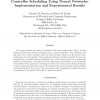Free Online Productivity Tools
i2Speak
i2Symbol
i2OCR
iTex2Img
iWeb2Print
iWeb2Shot
i2Type
iPdf2Split
iPdf2Merge
i2Bopomofo
i2Arabic
i2Style
i2Image
i2PDF
iLatex2Rtf
Sci2ools
HYBRID
1997
Springer
1997
Springer
Controller Scheduling Using Neural Networks: Implementation and Experimental Results
This paper presents the results of simulation and control experiments using a recently proposed method for real-time switching among a pool of controllers. The switching strategy selects the current controller based on neural network estimates of the future system performance for each controller. This neural-network-based switching controller has been implemented for a simulated inverted pendulum and a level control system for an underwater vehicle in our laboratory. The objectives of the experiments presented here are to demonstrate the feasibility of this approach to switching control for real systems and to identify techniques to deal with practical issues that arise in the training of the neural networks and the real-time switching behavior of the system. This experimental work complements on-going theoretical investigations of the method which will be reported elsewhere.
Control Systems | HYBRID 1997 | Neural-network-based Switching Controller | Real-time Switching | Real-time Switching Behavior |
| Added | 07 Aug 2010 |
| Updated | 07 Aug 2010 |
| Type | Conference |
| Year | 1997 |
| Where | HYBRID |
| Authors | Enrique D. Ferreira, Bruce H. Krogh |
Comments (0)

